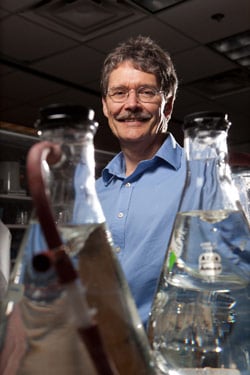
Scientists at the University of Georgia have discovered a way to transform carbon dioxide trapped in the atmosphere into useful industrial products, possibly allowing scientists to make biofuels from CO2 in the atmosphere.
Excess carbon dioxide in the Earth’s atmosphere created by the widespread burning of fossil fuels is the major driving force of global climate change, and researchers the world over are looking for new ways to generate power that leaves a smaller carbon footprint.
Now, researchers at the University of Georgia have found a way to transform the carbon dioxide trapped in the atmosphere into useful industrial products. Their discovery may soon lead to the creation of biofuels made directly from the carbon dioxide in the air that is responsible for trapping the sun’s rays and raising global temperatures.
“Basically, what we have done is create a microorganism that does with carbon dioxide exactly what plants do-absorb it and generate something useful,” said Michael Adams, member of UGA’s Bioenergy Systems Research Institute, Georgia Power professor of biotechnology and Distinguished Research Professor of biochemistry and molecular biology in the Franklin College of Arts and Sciences.

During the process of photosynthesis, plants use sunlight to transform water and carbon dioxide into sugars that the plants use for energy, much like humans burn calories from food.
These sugars can be fermented into fuels like ethanol, but it has proven extraordinarily difficult to efficiently extract the sugars, which are locked away inside the plant’s complex cell walls.
“What this discovery means is that we can remove plants as the middleman,” said Adams, who is co-author of the study detailing their results published March 25 in the early online edition of the Proceedings of the National Academies of Sciences. “We can take carbon dioxide directly from the atmosphere and turn it into useful products like fuels and chemicals without having to go through the inefficient process of growing plants and extracting sugars from biomass.”
The process is made possible by a unique microorganism called Pyrococcus furiosus, or “rushing fireball,” which thrives by feeding on carbohydrates in the super-heated ocean waters near geothermal vents. By manipulating the organism’s genetic material, Adams and his colleagues created a kind of P. furiosus that is capable of feeding at much lower temperatures on carbon dioxide.
The research team then used hydrogen gas to create a chemical reaction in the microorganism that incorporates carbon dioxide into 3-hydroxypropionic acid, a common industrial chemical used to make acrylics and many other products.
With other genetic manipulations of this new strain of P. furiosus, Adams and his colleagues could create a version that generates a host of other useful industrial products, including fuel, from carbon dioxide.
When the fuel created through the P. furiosus process is burned, it releases the same amount of carbon dioxide used to create it, effectively making it carbon neutral, and a much cleaner alternative to gasoline, coal and oil.
“This is an important first step that has great promise as an efficient and cost-effective method of producing fuels,” Adams said. “In the future, we will refine the process and begin testing it on larger scales.”
Reference: “Exploiting microbial hyperthermophilicity to produce an industrial chemical, using hydrogen and carbon dioxide” by Matthew W. Keller, Gerrit J. Schut, Gina L. Lipscomb, Angeli L. Menon, Ifeyinwa J. Iwuchukwu, Therese T. Leuko, Michael P. Thorgersen, William J. Nixon, Aaron S. Hawkins, Robert M. Kelly and Michael W. W. Adams, 25 March 2013, Proceedings of the National Academies of Sciences.
DOI: 10.1073/pnas.1222607110
The research was supported by the Department of Energy as part of the Electrofuels Program of the Advanced Research Projects Agency-Energy under Grant DE-AR0000081.
6 Comments
That man… is Walter White
That dude totally looks like Walter White
Great find, hopefully its not patented and obscured.
This my friends are double edge sience. Even though it’s good due to our fight towards green house effects, it’s also dangerous due to the impact it might have if we would gain an explosive growth of these P. furiosus and it’s a likes, as they eventually will escape a controled environment and thrive in the wild.
Is your headline writer uttering an April Fools joke? Making useful things out of CO2 in the air? They’re called ‘plants’ folks. They got ’em, even in Georgia.
Gotta admit. This is an amazing find. Producing the furiousis and causing it to thrive would be an interesting experiment. I agree that adding this “middle man” plant is a possible way to change the world. I’ve studied microbiology a little. I doubt it will “run the world”. I imagine it’s a lot like the crill or brine shrimp used to sanitize waste water on steam ships. The waste is put in a tank and the shrimp eat the bad bacteria, allowing the ships to dump the recycled water back to the ocean and it’s natural habitat to continue it’s path in the Eco system. Introducing a stimulant to cause the P. furiosis to work this process is doubtful to cause too much harm. Hydrogen is a strange chemical to work with. It would depend on how it was chemically introduced and as well as there are no chemicals escaping or spilling anywhere this could be really beneficial towards the impacts of our climate change. Good and interesting idea. Try it and test it!